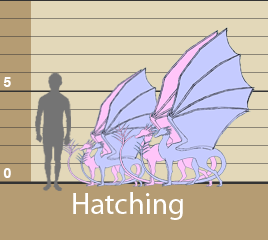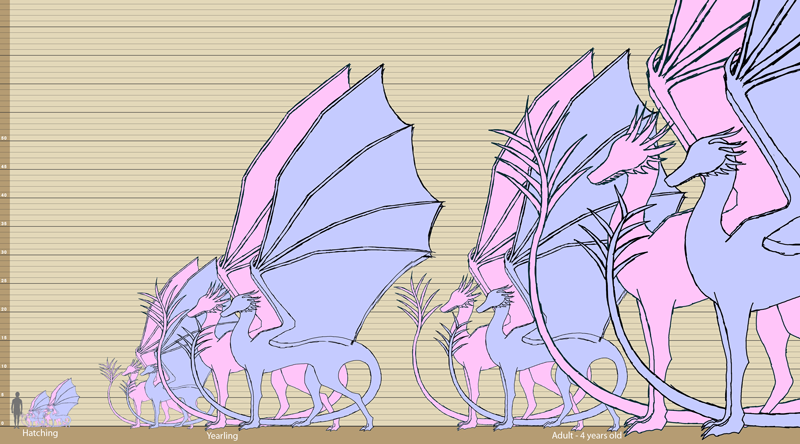

Like many other dragon eggs, Myrsilkain eggs, near hatching, are hard-shelled oblongs of varying mottled colors, often ranging from a creamy yellow to a brick red. Unlike other dragon eggs, though, Myrsilkain eggs are very small when laid, approximately the size of a full grown house cat, and the shells are soft and pliable to the touch (though the shells themselves are well over two inches thick at every point). It is during this time that the females tend to be broodiest, and it is not uncommon for the mother to become very threatening, or even violent, if anyone dares to get near their precious eggs. As time goes on, the eggs slowly absorb the magic in the area around them, and the pliable shells stretch and slowly harden as the dragon within grows. As the shells stretch, the thickness is reduced, until at the end the shell is usually no thicker than a quarter inch at any point.
Stunts usually occur when the shells harden too quickly for some reason, trapping the developing dragon within a smaller space than usual. Very few stunts survive, and those that do often have to be broken free from their shells. Even of those who are broken free, stunts often tend to be of weaker constitutions
Another reason that the females, and to some extent the males, so jealously guard their eggs is that, if taken away when the eggs are still small and soft, the shells will harden swiftly, and the eggs themselves, if taken away from a place with ample magic, will go dormant. These dormant eggs are prized by various greedy and power hungry individuals and races, as they act as a magnet for magic and exhibit the powers of the gender of their inhabitant. Eggs that contain a female Myrsilkain are sometimes referred to as call-stones, for their ability to summon to the wielder anything that the wielder sets his or her mind to, restricted only by how much magic the egg has available to gather from the world. The eggs that contain Myrsilk males are more often known as the sorcerer's stone, as they're often used as power boosters for various magic users, male or female.
The Myrsilk Dragons will do whatever they can to retrieve all of their lost eggs, though it is unknown if any of them will ever hatch, even if given the proper conditions.
The sands of Clan Akelara are highly magical in nature, in order to provide the developing dragons with enough magic to mature and develop properly. Unlike other sands of other Nexii dragonries, the sands of Clan Akelara are not true sand, but instead crushed and fragmented gemstones and crystals and have a tendency to glow somewhat brightly when there is a clutch of eggs resting upon them. This material is used because gemstones and crystals store and radiate magic more easily than normal sand, and ambient magic is a requirement for the hatchlings to properly mature.
If a mother clutches on regular sand, she will be much broodier than normal, with a tendency to remain curled about her clutch at all times, radiating magic for her hatchlings. She will not leave the sands for anything, even food, and therefore must be provided for by either her bond or her mate, for she will tolerate few, if any, others on the sands with her clutch.
The dragons, having tough hide, are not bothered by the rough surface, though it is advisable for any humanoid that steps onto the sands to have some sort of foot protection, as some of the fragments can be very sharp.
On the day of the hatching, all available dragons enter the hatching sands to witness the birth, and to encourage the youngsters to enter the world. Their welcome/encouragement is not the simple 'hum' of some of the other species of dragons out there, but more of a complex melody that beckons the hatchlings to strive as hard as they can to break free of their eggs. The melody, being a truly improvised piece, is slightly different at each hatching, and sometimes the overall mood of the melody can be influenced by big events that are on the minds of the Myrsilkains at that time (for example: sadness if some sad/depressing major event is linked with the hatching, say, the parents don't live to see the hatching for some reason, or something similar) but there is always the underlying joy of the hatching, and the sense of a warm welcome into the world. Again, unlike other species of dragons, the melody does not exactly cut off when the first egg cracks, but merely fades unobtrusively into the background.
Though most of the Myrsilk Dragons that live here right now have no bonds or partners, their past is riddled with occasionally entire clutches finding human or otherwise sentient bonds. And the Summoner-Sorcerer pairing that is in residence right now is considering opening everything up to beings that have the potential to bond with the children.
The hatchlings themselves, when they break shell, are usually about the size of an adult border collie, and ravenous, like most newborns. For some, their urge to bond will overwhelm their desire for food, and it is those that wind up finding their life-partners at their hatching. Their telepathy is naturally strong, but their speaking skills require time and practice in order to master, much like a human child. Some, unless pressed by their riders, will never push themselves to acquire that skill, and will remain physically mute except for the natural cries and calls of their race that they know almost instinctively. All hatchlings, though, unless otherwise mentioned, have the ability to communicate telepathically.

Hatchlings grow rapidly in their first year, leaving them, often, complaining about how they hurt and how much they itch. Once the worst of the hatchling hunger has worn off (usually by day two or three), many of them start observing the other Myrsilkains, and begin learning the theory behind flight and their powers. About halfway through the first year, it can be expected for most of them to begin attempting flight, though usually all they'll manage is a bit of a hover at best. Now, too, is when they start experimenting with their power... and must be watched closely, either by their bond, if they're bonded, or by an adult dragon if they're not, in order to make sure that they don't harm themselves.
By the time the first year is over, they've reached their half-way mark. At this point, most of them can be ridden for short distances by their bonds, and they usually have a fairly decent grasp of their powers. Some will feel the need to ask an older dragon for assistance in learning, while others might choose to go along with a purely trial and error method of learning.
Their growth during the second year is much slower, giving both bonder and dragon a welcome rest. They'll acquire their adult length by the time they're four, at the latest, though some have achieved it at three.
The following is a rough growth chart in feet, though the proportions of the hatchlings aren't exactly correct (hatchlings are longer, proportionately, than adults, and their wings are almost hilariously oversized). Click to view a larger, more readable version.
